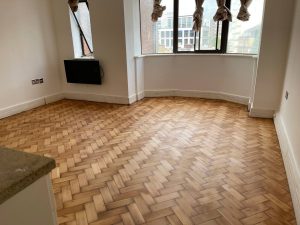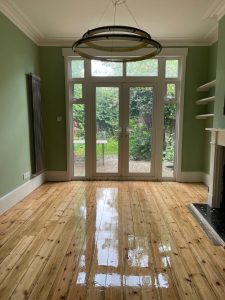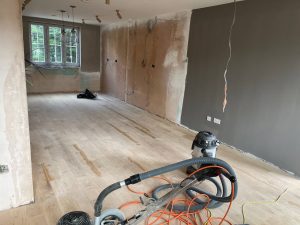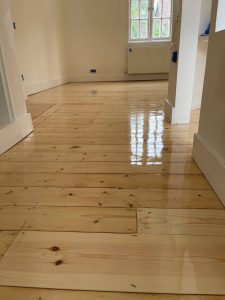How to Create Custom Floor Designs with Sanding and Staining

Transform your London home with unique and personalised wooden floor patterns
The Art of Custom Floor Designs
Creating custom floor designs with sanding and staining is an excellent way to add a personal touch to your London home. By combining different techniques and colours, you can achieve stunning and unique patterns that reflect your style. Here’s how to get started:
Preparation is Key
Before you begin creating custom designs, proper preparation is essential. Follow these steps to ensure a smooth and successful project:
1. Clean and Sand the Floor
Start by thoroughly cleaning your wooden floors to remove any dirt, dust, and debris. Then, sand the floors to create a smooth, even surface. This step is crucial for achieving a professional finish.
2. Plan Your Design
Decide on the pattern and design you want to create. Sketch your ideas on paper or use a design software to visualise the final look. Popular designs include chevron, herringbone, geometric patterns, and borders.
3. Gather Materials
Collect all the necessary materials, including sandpaper, staining products, painter’s tape, brushes, and stencils if needed. Choose high-quality stains to ensure vibrant and long-lasting colours.
Techniques for Custom Floor Designs

There are various techniques you can use to create custom floor designs. Here are some popular methods:
1. Geometric Patterns
Geometric patterns like herringbone and chevron are classic choices for wooden floors. Use painter’s tape to mark off the sections of the pattern and apply the stain carefully. Remove the tape once the stain is dry to reveal crisp lines.
2. Stencils
Stencils are a great way to add intricate designs to your floors. Place the stencil on the floor and secure it with tape. Apply the stain using a brush or sponge, ensuring even coverage. Lift the stencil carefully to avoid smudging.
3. Borders and Inlays
Add a touch of elegance with borders and inlays. Use contrasting stains to create a border around the room or a specific area. For inlays, consider using a darker stain to highlight certain sections of the floor.
4. Freehand Designs
If you’re feeling creative, try freehand designs. Use a brush to paint the stain directly onto the floor, creating unique patterns and shapes. This method allows for maximum creativity and personalisation.
Finishing Touches

Once your custom design is complete, it’s time to add the finishing touches:
1. Apply a Protective Sealant
After the stain has dried completely, apply a protective sealant to preserve the design and protect the wood. Choose a sealant that is compatible with your stain and provides the desired level of sheen.
2. Regular Maintenance
To keep your custom floor design looking its best, perform regular maintenance. Clean the floors with a gentle cleaner and avoid harsh chemicals that could damage the stain. Reapply the sealant as needed to maintain protection.
Professional Assistance
If you’re unsure about creating custom floor designs yourself, consider seeking professional assistance. Experienced flooring specialists in London can help bring your vision to life with precision and expertise. If you need professional help, contact us today. Our team is here to assist you with all your custom flooring needs.







The Ultimate Checklist for Floor Sanding Preparation
The Ultimate Checklist for Floor Sanding Preparation Ensure a Smooth and Efficient Floor Sanding[Read more...]
Case Studies: Successful Floor Sanding Projects in London
Floor sanding is an essential process for restoring and enhancing the beauty of wooden floors.[Read more...]
Floor sanding and renovation and installation services in Richmond
Richmond: A Jewel of London’s Green Boroughs Richmond is one of London’s most desirable and[Read more...]
Sand Hard Wood Flooring
Even the best wood floors are subject to damage. With time, hardwood floors scratch, dull,[Read more...]
The Best Floor Sanding Practices for Older Homes
The Best Floor Sanding Practices for Older Homes Older homes in London often feature beautiful[Read more...]
Step-by-Step Floor Sanding Process for Beginners
If you’re a homeowner in London looking to rejuvenate your wooden floors, floor sanding can[Read more...]
How to Achieve a Rustic Look with Floor Sanding
How to Achieve a Rustic Look with Floor Sanding Transform your London home with[Read more...]
How to Create a Vintage Look with Floor Sanding and Finishing
How to Create a Vintage Look with Floor Sanding and Finishing Creating a vintage[Read more...]
The Best Maintenance Practices for Sanded Floors in Humid Climates
The Best Maintenance Practices for Sanded Floors in Humid Climates Keep your London home’s[Read more...]
How to Identify and Repair Water Damage Before Sanding
How to Identify and Repair Water Damage Before Sanding Ensure your London home’s floors[Read more...]